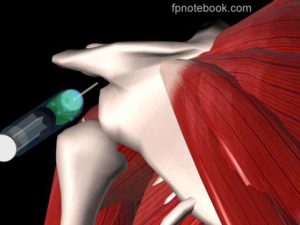Corticosteroid (cortisone) Injection – some facts behind the myth !!
CORTICOSTEROID (cortisone) INJECTION – Some facts behind the myth
At some point many of us have had or heard of someone who has had a “cortisone” injection. In my talks with patients over the years cortisone often gets a bad rap! The truth is , if used correctly and in the hands of an expert it is a powerful and effective way of managing some inflammatory conditions. So much so that we often see instant relief of a condition that has proven stubborn to many other types of more conservative treatment such as physiotherapy.
Corticosteroids are a class of medications that are related to cortisone, a steroid. Medications of this class powerfully reduce inflammation. Corticosteroids are not pain relievers. They reduce inflammation. When corticosteroids relieve pain, it is because they have reduced inflammation associated with that condition.
While the inflammation for which corticosteroids are given can recur, corticosteroid injections can provide months to years of relief when used properly. Examples of common conditions that an inection of CS may be useful for would be bursitis (hip, knee, shoulder), osteoarthritis (hip, knee) and painful foot conditions such as plantar fasciitis.
The most important issue accompanying CS injection is to realise that the injection is merely a powerful anti-inflammatory medication. It will not change any of the underlying risk factors or causes (“drivers”) of the condition. For this reason CS injection can have several outcomes
1. Full resolution of symptoms with no recurrence
2. Full resolution of symptoms for minimum or moderate period followed by recurrence
3. Minimum -Moderate resolution of symptoms followed by 2-3 further injections at varying intervals
4. No change in symptoms
It is likely that people who experience 1 or 2 will give CS injections a great rap! At the other end of the spectrum these people will likely give CS injection a “thumbs down” and usually go on to tell their friends and anyone else who might be having an injection about the negative experience they have had. Reasons why an injection may not have worked could be as follows
– the condition did not warrant an injection
– the injection missed the inflammed structure
– the structure did not have an inflammtory pathology within it
In my experience people who show either of 2,3 or 4 (above) need to explore further into the underlying “driver” of the condition. This is where physiotherapy can be of most assistance. Our background training is to understand and manage the underlying causes and associated risk factors for various conditions. Exercises, retraining, advice and hands on therapy are all techniques that will aid in correcting the “driver” of a condition and give you a far better outcome.
I had a client recently who had a stubborn shoulder condition and was unable to perform some of their necessary drills for rehab – i subsequently referred them to our on site sports doctor – Dr David Hart. He performed a CS injection which gave 50-60% relief – enough to enable the exercises to be performed with more comfort which successfully changed the underlying cause of the condtion and allowed recovery.
In many cases now doctors are sending people for guided injections (ultrasound or CT guided). This ensures greated accuracy and thus better relief.
If an injection is something you have been asked to have it is important to understand the risks and benefits associated with the procedure. Injection and repeated injection into tendons has shown to be a dangerous practice as the CS weakens the tendon structure and has been implicated in tendon rupture.
So if you are unsure about CS injection for a condition you might have feel free to discuss it with any of the team at Physiologic

